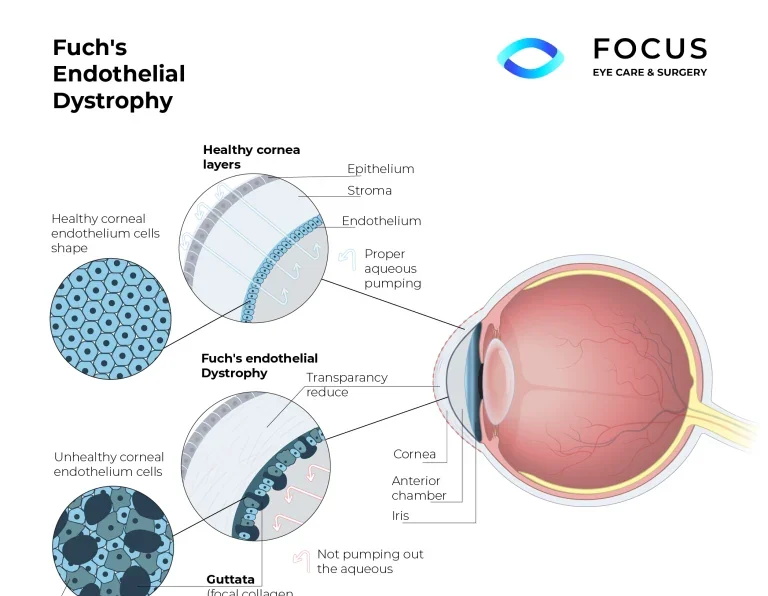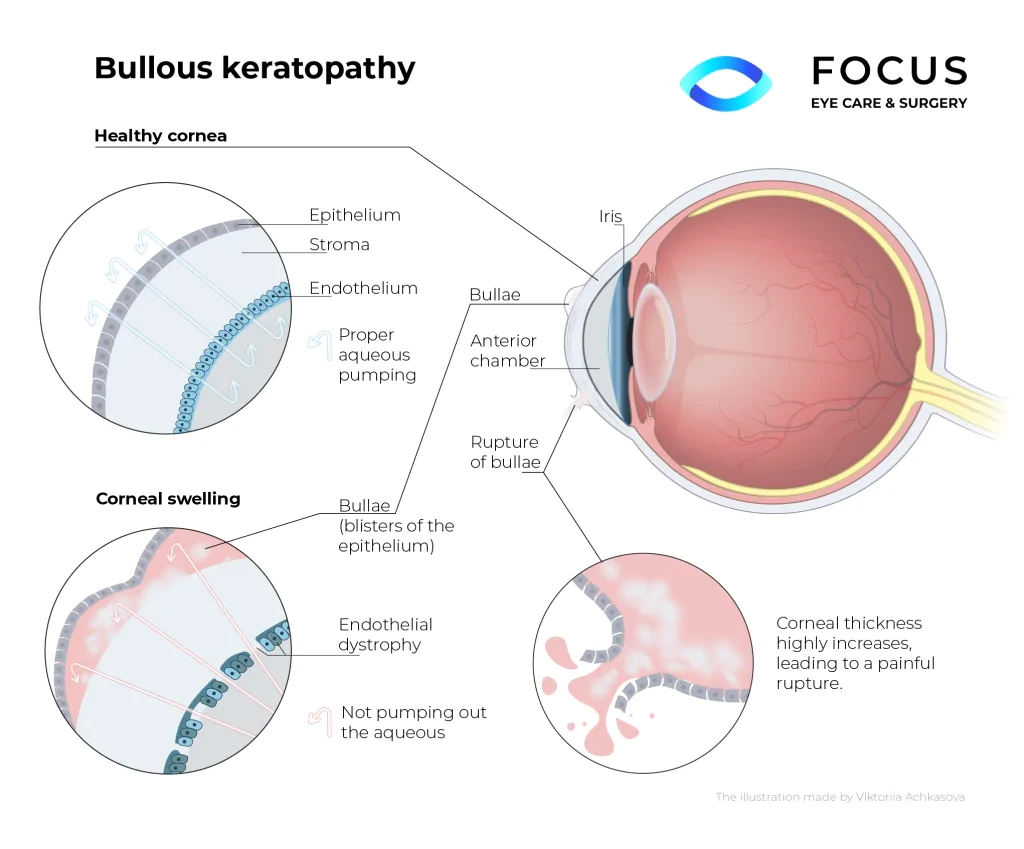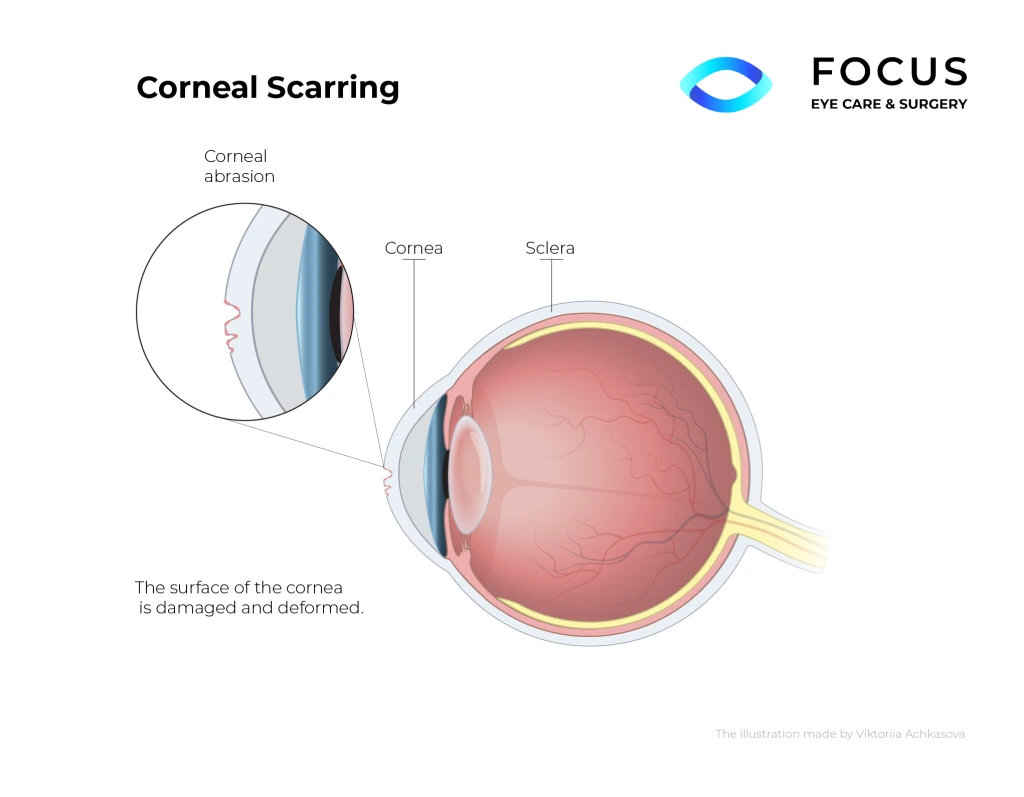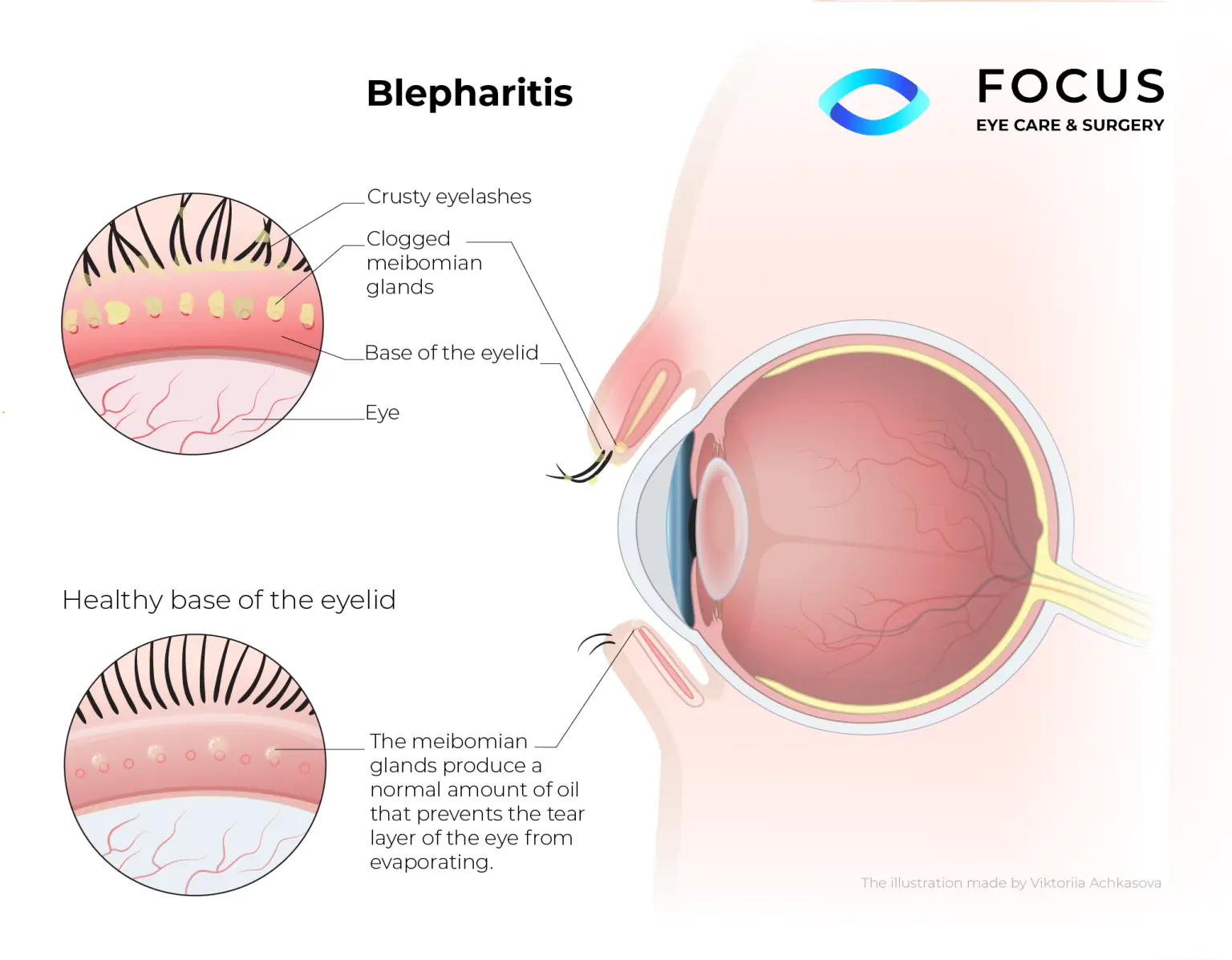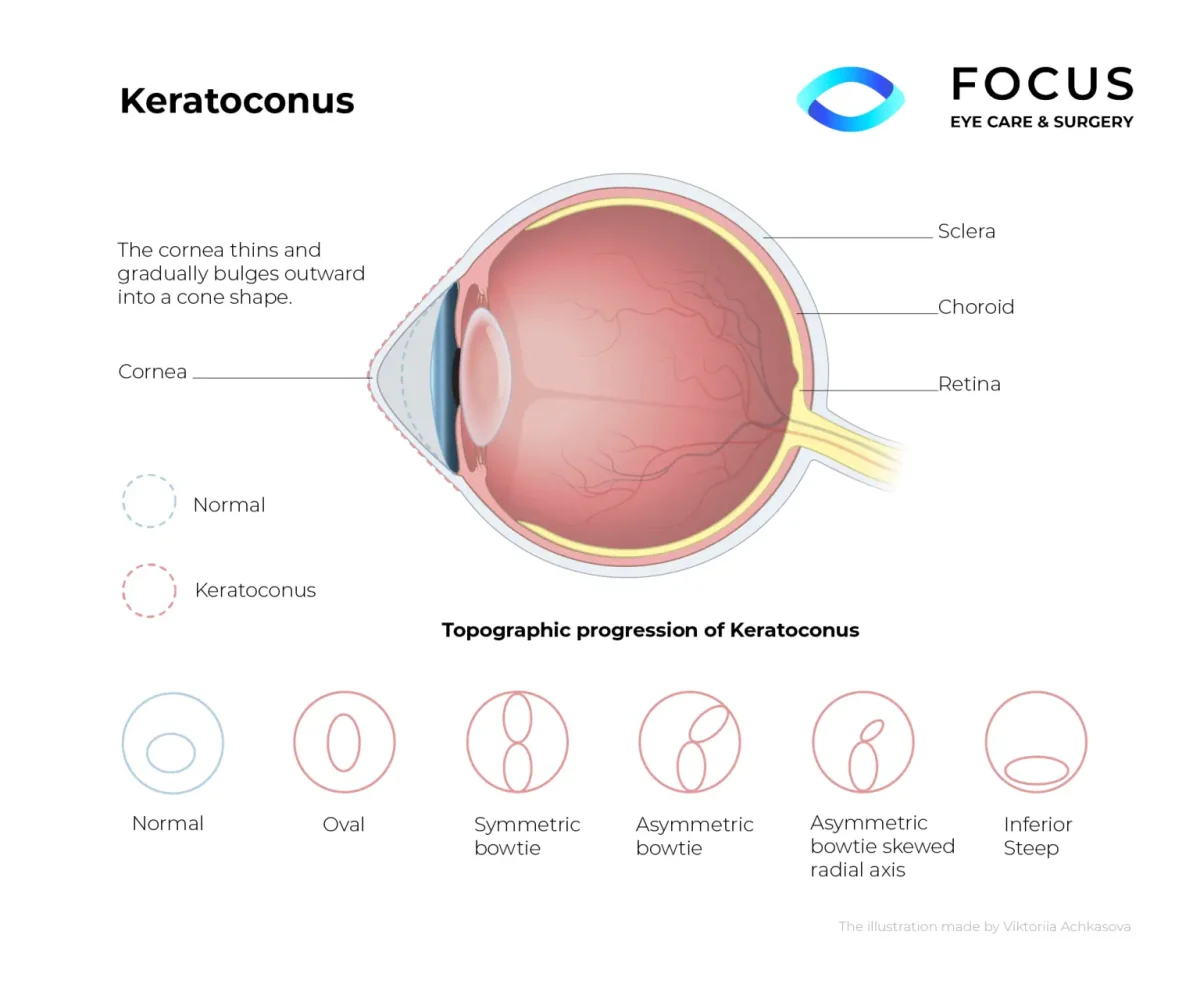Corneal Conditions
at Focus Eye Care & Surgery
At Focus Eye Care, we provide comprehensive care for various corneal conditions, serving patients across Queens, Long Island, and NYC. Our team is dedicated to diagnosing and managing eye conditions that impact the cornea to help you maintain clear, comfortable vision.
Fuchs' Dystrophy
Fuchs’ dystrophy is a progressive corneal condition where cells in the innermost layer of the cornea, called the endothelium, gradually deteriorate. As these cells lose function, fluid accumulates within the cornea, causing swelling and clouding that can significantly impair vision. This condition
Trusted Source
What is Fuchs’ Dystrophy?
American Academy of Ophthalmology
Go to Source
typically
affects both eyes and may become more apparent as people age, particularly after age 50.
Symptoms of Fuchs’ Dystrophy
- Blurred or hazy vision, especially upon waking up
- Sensitivity to light (photophobia)
- Glare and halos around lights
- Eye discomfort or a gritty sensation
Treatment for Fuchs’ Dystrophy
Treatment for Fuchs’ dystrophy can range from symptom management to advanced procedures. In early stages, using saline drops or ointments may reduce corneal swelling temporarily. For advanced cases, corneal transplantation surgery, such as Descemet membrane endothelial keratoplasty (DMEK), may be
Trusted Source
Fuchs’ Dystrophy
Cornea Research Foundation of America
Go to Source
recommended
to restore clarity and vision.
Bullous Keratopathy
Bullous keratopathy occurs when corneal swelling leads to fluid-filled blisters on the cornea’s surface. This condition can result from various causes, such as endothelial damage during cataract surgery, trauma, or complications from glaucoma. When these blisters break, they can
Trusted Source
Pseudophakic Bullous Keratopathy
Gurnani B, Kaur K.
Go to Source
cause
significant discomfort, redness, and visual disturbances.
Symptoms of Bullous Keratopathy
- Eye pain, especially when blinking
- Persistent redness
- Blurry vision
- Light sensitivity
Treatment for Bullous Keratopathy
Managing bullous keratopathy typically begins with supportive treatments, like saline solutions and bandage contact lenses, to relieve pain. In cases where symptoms persist, surgical options such as endothelial keratoplasty (EK) or full corneal transplant (penetrating keratoplasty) may be considered.
Corneal Scarring
Corneal scarring develops as a result of injury, infection, or inflammation, leaving opaque areas that interfere with light passing through the cornea. Scarring may vary in severity, with some scars being faint and others causing significant vision obstruction.
Symptoms of Corneal Scarring
- Blurred or obstructed vision
- Light sensitivity
- Redness or discomfort (if related to active inflammation)
Treatment for Corneal Scarring
Mild scarring may require no treatment, while more severe cases might need medical or surgical intervention. Options include laser treatments like phototherapeutic keratectomy (PTK) to remove scar tissue, or, for deep scars, a corneal transplant may be necessary.
Blepharitis
Blepharitis is a common and chronic inflammation of the eyelid margins. It occurs when the small oil glands located near the base of the eyelashes become clogged, leading to irritated, itchy, and red eyelids. While it is not usually sight-threatening, blepharitis can be uncomfortable and persistent. There are two primary types of blepharitis, anterior and posterior, which may occur separately or
Trusted Source
What is Blephratis?
American Academy of Ophthalmology
Go to Source
together
.
Symptoms of Blepharitis
- Red, swollen, or itchy eyelids
- Crusty buildup at the base of the lashes
- Watery or irritated eyes
- Sensitivity to light
Treatment for Blepharitis
While there is no cure for blepharitis, regular eyelid hygiene can help manage symptoms. This includes warm compresses, gentle cleansing of the eyelid area, and prescribed medicated ointments or drops. In some cases, antibiotic or steroid treatments are
Trusted Source
Blepharitis
Mayo Clinic
Go to Source
recommended
to reduce inflammation and bacterial growth.
Keratoconus
Keratoconus is a progressive eye condition that weakens the cornea, causing it to thin and bulge into a cone-like shape. This irregular curvature distorts light as it enters the eye, leading to blurry or distorted vision. The condition often begins in the teenage years or early adulthood and can worsen over time if left untreated. While the exact cause of keratoconus is not fully understood, it is believed to have a genetic component and may be linked to eye rubbing or underlying
Trusted Source
Keratoconus
American Academy of Ophthalmology
Go to Source
conditions
like allergies.
Symptoms of Keratoconus
- Blurred or distorted vision
- Sensitivity to light and glare
- Frequent changes in eyeglass prescriptions
- Difficulty seeing at night
- Double vision or “ghosting” in one eye
Treatment for Keratoconus
Treatment for keratoconus depends on the severity of the condition:
- Early stages: Mild keratoconus can often be managed with eyeglasses or custom-fitted contact lenses, such as scleral lenses, to correct vision.
- Corneal Cross-Linking: For progressive keratoconus, corneal cross-linking is a minimally invasive procedure that strengthens the cornea by creating new collagen bonds. During the procedure, riboflavin (vitamin B2) drops are applied to the cornea and activated with UV light, halting the progression of the disease. This treatment is highly effective in preventing further thinning and distortion.
- Advanced cases: If keratoconus significantly impairs vision, surgical options like corneal transplantation may be considered.
- Corneal Tissue Addition Keratoplasty (CTAK): For patients with moderate to advanced keratoconus, CTAK offers a less invasive alternative to corneal transplant. The procedure strengthens and reshapes the cornea by adding thin donor tissue, improving stability and vision. Dr. Ghaznawi is the first ophthalmologist in NYC to perform this innovative treatment.
FAQs About Corneal Conditions
Corneal conditions can stem from genetics, infections, trauma, or systemic diseases. The causes vary by condition, so it’s essential to consult with an eye care specialist for an accurate diagnosis. American Academy of Ophthalmology
To determine the presence and extent of corneal conditions, an ophthalmologist may perform a series of diagnostic tests, including:
- Slit-lamp examination: Provides a magnified view of the cornea’s surface and structure, allowing the ophthalmologist to detect issues such as scarring, thinning, or inflammation.
- Corneal topography: Maps the cornea’s curvature, helping to identify irregularities or bulging, which is often associated with keratoconus.
- Pachymetry: Measures the thickness of the cornea, which is essential for diagnosing conditions like Fuchs’ dystrophy.
- Optical coherence tomography (OCT): Produces detailed cross-sectional images of the cornea’s layers, allowing for deeper insights into the extent and type of corneal disease.
These diagnostic tests provide a comprehensive view of corneal health, enabling the ophthalmologist to create a targeted treatment plan.
While some corneal conditions, like Fuch’s dystrophy, are hereditary and cannot be prevented, protecting your eyes from injury, infection, and UV exposure can help reduce risks of developing other corneal
Trusted Source
Corneal Conditions
National Eye Institute
Go to Source
issues
.
A corneal transplant, also known as keratoplasty, is a surgical procedure in which damaged or diseased corneal tissue is replaced with healthy donor tissue. This surgery is used to restore vision, reduce pain, and improve the appearance of a damaged or scarred cornea.
There are several types of corneal transplants:
- Penetrating Keratoplasty (PK): A full-thickness transplant replacing all layers of the cornea.
- Endothelial Keratoplasty (EK): Replaces only the innermost layer, the endothelium. DMEK (Descemet membrane endothelial keratoplasty) and DSAEK (Descemet stripping automated endothelial keratoplasty) are common forms.
- Anterior Lamellar Keratoplasty (ALK): Replaces only the front layers of the cornea, leaving the inner layers intact.
Corneal transplant surgery is usually performed on an outpatient basis under local or general anesthesia. The surgeon removes the damaged section of the cornea and replaces it with a donor cornea, which is then secured with sutures or, in some types of surgery, left to heal without them.
Schedule a Consultation
If you’re experiencing symptoms related to corneal conditions or have concerns about your eye health, contact Focus Eye Care. We proudly serve patients from Queens, Long Island, and throughout the NYC area, offering specialized care tailored to each patient’s needs.
1 American Academy of Ophthalmology. What is Fuchs’ Dystrophy? Available: https://www.aao.org/eye-health/diseases/what-is-fuchs-dystrophy. Accessed November 12, 2024.
2 Cornea Research Foundation of America. Fuchs’ Dystrophy. Available: https://cornea.org/Learning-Center/Conditions-Research-Areas/Fuchs-Dystrophy.aspx. Accessed November 12, 2024.
3 Gurnani B, Kaur K. Pseudophakic Bullous Keratopathy. [Updated 2023 Aug 28]. In: StatPearls [Internet]. Treasure Island (FL): StatPearls Publishing; 2024 Jan-. Available from: https://www.ncbi.nlm.nih.gov/books/NBK574505/. Accessed November 12, 2024.
4 American Academy of Ophthalmology. What is Blephratis? Available: https://www.aao.org/eye-health/diseases/what-is-blepharitis. Accessed November 12, 2024.
5 Mayo Clinic. Blepharitis. Available: https://www.mayoclinic.org/diseases-conditions/blepharitis/symptoms-causes/syc-20370141. Accessed November 12, 2024.
6 American Academy of Ophthalmology. Keratoconus. Available: https://www.aao.org/eye-health/diseases/what-is-keratoconus. Accessed November 15, 2024.
7 National Eye Institute. Corneal Conditions. Available: https://www.nei.nih.gov/learn-about-eye-health/eye-conditions-and-diseases/corneal-conditions. Accessed November 12, 2024.

